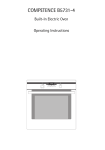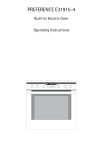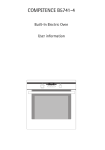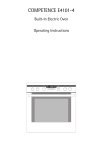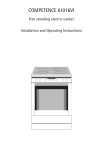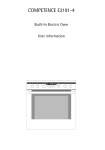Download AEG Electrolux COMPETENCE E5731-4 Operating instructions
Transcript
COMPETENCE E5731-4 Built-In Electric Oven Operating Instructions Dear Customer, Please read these user instructions carefully and keep them to refer to later. Please pass the user instructions on to any future owner of the appliance. 1 3 2 2 The following symbols are used in the text: Safety instructions Warning! Information that affects your personal safety. Important! Information that prevents damage to the appliance. Useful tips and hints Environmental information Contents Operating Instructions . . . . . . . . . . . . . . . . . . . . . . . . . . . . . . . . . . . . . 5 Safety instructions. . . . . . . . . . . . . . . . . . . . . . . . . . . . . . . . . . . . . . . . . . . . . . 5 Disposal . . . . . . . . . . . . . . . . . . . . . . . . . . . . . . . . . . . . . . . . . . . . . . . . . . . . . . . 7 Description of the Appliance . . . . . . . . . . . . . . . . . . . . . . . . . . . . . . . . . . . . . 8 General Overview. . . . . . . . . . . . . . . . . . . . . . . . . . . . . . . . . . . . . . . . . . . . . . . . 8 Control Panel . . . . . . . . . . . . . . . . . . . . . . . . . . . . . . . . . . . . . . . . . . . . . . . . . . . 8 Oven Features. . . . . . . . . . . . . . . . . . . . . . . . . . . . . . . . . . . . . . . . . . . . . . . . . . . 9 Oven accessories . . . . . . . . . . . . . . . . . . . . . . . . . . . . . . . . . . . . . . . . . . . . . . . . 10 Before Using for the first time . . . . . . . . . . . . . . . . . . . . . . . . . . . . . . . . . . . 11 Setting and changing the time . . . . . . . . . . . . . . . . . . . . . . . . . . . . . . . . . . . . 11 Initial cleaning . . . . . . . . . . . . . . . . . . . . . . . . . . . . . . . . . . . . . . . . . . . . . . . . . . 12 Using the Rings. . . . . . . . . . . . . . . . . . . . . . . . . . . . . . . . . . . . . . . . . . . . . . . . . 13 Setting the heat setting . . . . . . . . . . . . . . . . . . . . . . . . . . . . . . . . . . . . . . . . . . 14 Using the Oven . . . . . . . . . . . . . . . . . . . . . . . . . . . . . . . . . . . . . . . . . . . . . . . . . Switching the Oven On and Off . . . . . . . . . . . . . . . . . . . . . . . . . . . . . . . . . . . . Speedcook. . . . . . . . . . . . . . . . . . . . . . . . . . . . . . . . . . . . . . . . . . . . . . . . . . . . . . Oven Functions. . . . . . . . . . . . . . . . . . . . . . . . . . . . . . . . . . . . . . . . . . . . . . . . . . Meat probe . . . . . . . . . . . . . . . . . . . . . . . . . . . . . . . . . . . . . . . . . . . . . . . . . . Inserting the Shelf and Tray . . . . . . . . . . . . . . . . . . . . . . . . . . . . . . . . . . . . . . . Non-stick accessories . . . . . . . . . . . . . . . . . . . . . . . . . . . . . . . . . . . . . . . . . . . . Inserting/Removing the Grease Filter . . . . . . . . . . . . . . . . . . . . . . . . . . . . . . . Clock Functions . . . . . . . . . . . . . . . . . . . . . . . . . . . . . . . . . . . . . . . . . . . . . . . . . Other Functions . . . . . . . . . . . . . . . . . . . . . . . . . . . . . . . . . . . . . . . . . . . . . . . . . Switching off the display . . . . . . . . . . . . . . . . . . . . . . . . . . . . . . . . . . . . . . Oven’s child safety device . . . . . . . . . . . . . . . . . . . . . . . . . . . . . . . . . . . . . . Oven safety cut-out. . . . . . . . . . . . . . . . . . . . . . . . . . . . . . . . . . . . . . . . . . . Mechanical Door Lock . . . . . . . . . . . . . . . . . . . . . . . . . . . . . . . . . . . . . . . . . . . . 15 15 18 19 20 22 23 23 24 30 30 30 31 32 3 Uses, Tables and Tips . . . . . . . . . . . . . . . . . . . . . . . . . . . . . . . . . . . . . . . . . . . . Cooking table . . . . . . . . . . . . . . . . . . . . . . . . . . . . . . . . . . . . . . . . . . . . . . . . . . . Baking . . . . . . . . . . . . . . . . . . . . . . . . . . . . . . . . . . . . . . . . . . . . . . . . . . . . . . . . . Baking table . . . . . . . . . . . . . . . . . . . . . . . . . . . . . . . . . . . . . . . . . . . . . . . . . Table for Bakes and Gratins. . . . . . . . . . . . . . . . . . . . . . . . . . . . . . . . . . . . . Frozen Ready Meals Table . . . . . . . . . . . . . . . . . . . . . . . . . . . . . . . . . . . . . . Roasting . . . . . . . . . . . . . . . . . . . . . . . . . . . . . . . . . . . . . . . . . . . . . . . . . . . . . . . Roasting table. . . . . . . . . . . . . . . . . . . . . . . . . . . . . . . . . . . . . . . . . . . . . . . . Meat probe Table . . . . . . . . . . . . . . . . . . . . . . . . . . . . . . . . . . . . . . . . . . . . . Grill Sizes . . . . . . . . . . . . . . . . . . . . . . . . . . . . . . . . . . . . . . . . . . . . . . . . . . . . . . Grilling table . . . . . . . . . . . . . . . . . . . . . . . . . . . . . . . . . . . . . . . . . . . . . . . . . Defrosting . . . . . . . . . . . . . . . . . . . . . . . . . . . . . . . . . . . . . . . . . . . . . . . . . . . . . . Defrosting table . . . . . . . . . . . . . . . . . . . . . . . . . . . . . . . . . . . . . . . . . . . . . . Making Preserves . . . . . . . . . . . . . . . . . . . . . . . . . . . . . . . . . . . . . . . . . . . . . . . . 33 33 34 36 40 40 41 42 44 45 45 46 46 47 Cleaning and Care . . . . . . . . . . . . . . . . . . . . . . . . . . . . . . . . . . . . . . . . . . . . . . Outside of the appliance. . . . . . . . . . . . . . . . . . . . . . . . . . . . . . . . . . . . . . . . . . Oven interior . . . . . . . . . . . . . . . . . . . . . . . . . . . . . . . . . . . . . . . . . . . . . . . . . . . Accessories . . . . . . . . . . . . . . . . . . . . . . . . . . . . . . . . . . . . . . . . . . . . . . . . . . . . . Non-stick accessories . . . . . . . . . . . . . . . . . . . . . . . . . . . . . . . . . . . . . . . . . . . . Fat Filter . . . . . . . . . . . . . . . . . . . . . . . . . . . . . . . . . . . . . . . . . . . . . . . . . . . . . . . Shelf Support Rails . . . . . . . . . . . . . . . . . . . . . . . . . . . . . . . . . . . . . . . . . . . . . . Oven Lighting . . . . . . . . . . . . . . . . . . . . . . . . . . . . . . . . . . . . . . . . . . . . . . . . . . . Oven Ceiling . . . . . . . . . . . . . . . . . . . . . . . . . . . . . . . . . . . . . . . . . . . . . . . . . . . . Oven Door. . . . . . . . . . . . . . . . . . . . . . . . . . . . . . . . . . . . . . . . . . . . . . . . . . . . . . Oven Door Glass . . . . . . . . . . . . . . . . . . . . . . . . . . . . . . . . . . . . . . . . . . . . . . . . . 49 49 49 49 50 50 51 52 53 54 55 What to do if … . . . . . . . . . . . . . . . . . . . . . . . . . . . . . . . . . . . . . . . . . . . . . . . . 57 Service 4 . . . . . . . . . . . . . . . . . . . . . . . . . . . . . . . . . . . . . . . . . . . . . . . . . . . . . . 59 Operating Instructions 1 Safety instructions 5 This appliance conforms with the following EU Directives: – 73/23/EEC dated 19.02.1973 Low Voltage Directive – 89/336/EEC dated 03.05.1989 EMC Directive inclusive of Amending Directive 92/31/EEC – 93/68/EEC dated 22.07.1993 CE Marking Directive Electrical safety • This appliance must be only connected by a registered electrician. • In the event of a fault or damage to the appliance: Take the fuses out or switch off. • Repairs to the appliance must only be carried out by qualified service engineers. Considerable danger may result from improper repairs. If repairs become necessary, please contact our Customer Services or your dealer. Child Safety • Never leave children unsupervised when the appliance is in use. Safety whilst Using • This appliance is intended to be used for cooking, roasting and baking food in the home. • Take care when connecting electric appliances to sockets nearby. Do not allow connecting leads to come into contact with or to catch beneath the hot oven door. • Warning: Risk of burns! The interior of the oven becomes hot during use. • Using ingredients containing alcohol in the oven may create an alcohol-air mixture that is easily ignited. In this case, open the door carefully. Do not have embers, sparks or naked flames in the vicinity when opening the door. 3 Information on acrylamides According to the latest scientific knowledge, intensive browning of food, especially in products containing starch, can constitute a health risk due to acrylamides. Therefore we recommend cooking at the lowest possible temperatures and not browning foods too much. 5 How to avoid damage to the appliance • Do not line the oven with aluminium foil and do not place baking trays, pots, etc. on the oven floor, as the heat that builds up will damage the oven enamel. • Fruit juices dripping from the baking tray will leave stains, which you will not be able to remove. For very moist cakes, use a deep tray. • Do not put any strain on the oven door when open. • Never pour water directly into the oven when it is hot. This could cause damage to or discoloration of the enamel. • Rough handling, especially around the edges of the front panel, can cause the glass to break. • Do not store any flammable materials inside the oven. These could ignite when the oven is switched on. • Do not store any moist foods inside the oven. This could damage the oven enamel. 3 6 Note on enamel coating Changes in the colour of the oven’s enamel coating as a result of use do not affect the appliance’s suitability for normal and correct use. They therefore do not constitute a defect in the sense of the warranty law. Disposal 2 2 Packaging material The packaging materials are environmentally friendly and can be recycled. The plastic components are identified by markings, e.g. >PE<, >PS<, etc. Please dispose of the packaging materials in the appropriate container at the community waste disposal facilities. Old appliance W 1 The symbol on the product or on its packaging indicates that this product may not be treated as household waste. Instead it shall be handed over to the applicable collection point for the recycling of electrical and electronic equipment. By ensuring this product is disposed of correctly, you will help prevent potential negative consequences for the environment and human health, which could otherwise be caused by inappropriate waste handling of this product. For more detailed information about recycling of this product, please contact your local city office, your household waste disposal service or the shop where you purchased the product. Warning: So that the old appliance can no longer cause any danger, make it unusable before disposing of it. To do this, disconnect the appliance from the mains supply and remove the mains cable from the appliance. 7 Description of the Appliance General Overview Control panel Door handle Full glass door Control Panel Temperature / Time Display Function buttons Temperature / Oven Functions Time Selection Hob Cooking Zone Control Knobs Hob Cooking Zone Control Knobs 8 Oven Features Top heat and heating elements Oven lighting Shelf positions Meat probe socket Fat Filter Fan heating element Fan Bottom Heat Oven shelf runners, removable Oven steam vent The steam from the oven is fed directly upwards via the duct in the rear of the cooking surface. 9 Oven accessories Oven shelf For cookware, cake tins, roasts and grilled foods. Oven shelf for non-stick For cookware, cake tins, roasts and grilled foods. Baking tray For cakes and biscuits. Non-stick baking tray For cakes and biscuits. Non-stick roasting pan For roasting or for collecting fat. Meat probe For determining exactly how far joints of meat are cooked. 10 Before Using for the first time Setting and changing the time 3 The oven only operates when the time has been set. When the appliance has been connected to the electrical supply or when there has been a power cut, the function indicator Time flashes automatically. 1. To change a time that has already been set, press the Select button repeatedly until the function indicator Time flashes. 2. Using the / control knob, set the current time. After approx. 5 seconds, the flashing stops and the clock displays the time of day set. 3 The appliance is now ready to use. The time can only be modified, if the child safety device is deactivated, none of the Countdown , Cook time or End time clock functions and no oven function is set. 11 Initial cleaning 1 3 Clean the oven before using it for the first time. Important: Do not use caustic or abrasive cleaning agents! These can damage the oven surfaces. For the metal surfaces, use commercially available cleaning agents. 1. Open the oven door. The oven light is lit. 2. Remove all oven accessories, and clean them with warm water and a scouring agent. 3. Wash the oven in the same way, and wipe dry. 4. Wipe the front of the appliance with a damp cloth. 12 Using the Rings 3 Also refer to the operating instructions for your built-in hob. It contains important information on ovenware, operation, cleaning and care. Heat settings • You may select the heat settings within the range of settings 1-9. • Intermediate positions may be selected between settings 2 and 7. 2 3 1 = lowest heat setting 9 = highest heat setting Switch the cooking zone off approx. 5-10 minutes before cooking is finished to make use of the residual heat. This saves electricity. The cooker has pop-up ring switches. Press the ring switch to use it. The switch will then pop up. front left rear left rear right front right Hob Cooking Zone Control Knobs 13 Setting the heat setting 1. Select the heat setting. 3 14 2. To end the cooking process, turn back to the Off position. The corresponding ring pilot light is lit while the ring is operating. Using the Oven 3 The oven is equipped with retractable buttons for “Oven functions” and “Temperature selection”. To use, press the relevant button. The button then sticks out. Switching the Oven On and Off Temperature / Time Display Speedcook Heat indicator Button Speedcook Oven Functions Change display Selector Button Temperature / Time Selection Switching oven on Turn the oven functions control knob to the desired function. The temperature display shows the suggested temperature for the oven function selected. The oven starts to heat up. When the temperature set is reached, an audible signal sounds. 15 Changing the oven temperature Use the / control knob to raise or lower the temperature. The setting changes in steps of 5 °C. Switching the oven off To turn the oven off, turn the oven functions control knob to the OFF position. 3 16 Cooling fan The fan switches on automatically in order to keep the appliance’s surfaces cool. When the oven is switched off, the fan continues to run to cool the appliance down, then switches itself off automatically. 3 Heat indicator Indicates warming up When the oven function has been switched on the bars that slowly light up one after the other indicate how far the oven has heated up. Fast heat indicator When the fast heat function has been switched on the bars that flash one after the other indicate that fast heat is operating. In addition the bars next to the symbol light up. Residual heat indicator When the oven has been switched off, the bars that are still lit indicate the remaining residual heat in the oven. 17 Speedcook 1 3 18 After an oven function is selected, using the additional function Speedcook the empty oven can be pre-heated in a relatively short time. Important: Do not put the food to be cooked into the oven, until Speedcook is completed and the oven is operating using the desired function. 1. Set the desired oven function (e. g., Conventional ). If necessary, change the suggested temperature. 2. Press the Speedcook button. The bars next to the symbol light up. When the bars flash one after another it shows that Speedcook is operating. When the temperature set is reached, the bars of the heat indicator light up and the bars next to the symbol go out. An audible signal sounds. The oven now continues heating according to the pre-set oven function and temperature. You can now place the food in the oven. The Speedcook function can be switched on with the oven functions Professional hot air , Conventional and Rotitherm . Oven Functions The oven has the following functions: Oven function Application Heating element/ fan Professional hot air For baking on up to three oven levels at the same time. Set the oven temperatures 20-40 °C lower than when using Conventional. Top heat, bottom heat, rear wall heating element, fan Conventional For baking and roasting on one oven level. Top heat, bottomheat Rotitherm For roasting larger joints of meat or poultry on one level. The function is also suitable for gratinating and browning. Grill, top heat, fan Dual grill For grilling flat foodstuffs in Grill, top heat large quantities and for toasting. Grill For grilling flat foodstuffs placed Grill in the middle of the grill and for toasting. Defrost For defrosting e. g. flans and ga- Fan teaux, butter, bread, fruit or other frozen foods. Bottom heat For baking cakes with crispy or crusty bases. Bottom heat 19 Meat probe 1 For switching off the oven when the temperature at the centre of a roast reaches a set temperature. There are two temperatures to be set: – The oven temperature: see Roasting Table – The core temperature: See Meat probe Table Important: Only the meat probe supplied may be used. If replacing, please use only original replacement parts. 3. Push the tip of the meat probe right into the meat so that the tip is in the centre of the meat. 4. Insert the meat probe plug into the socket on the oven side wall as far as it will go. 5. Using the / control knob set the desired core temperature. 3 20 The display changes to the current core temperature If the current core temperature has already been displayed, before the desired core temperature is set, then press the Select button repeatedly, until the function Meat probe flashes and then carry out the setting. The core temperature is displayed from 30°C. 6. Set the oven function and oven temperature. As soon as the core temperature set is reached, an audible signal sounds and the oven switches itself off automatically. 7. To switch off the signal, press any button. 1 Warning: The meat probe is hot. There is a risk of being burned when removing the plug and the tip of the meat probe. 8. Remove the meat probe’s plug from the socket and take the meat out of the oven. 9. Switch off appliance. Checking or changing the core temperature – Press the Select button repeatedly until the function Meat probe flashes and the core temperature set appears in the display. – If necessary, change the temperature using or . Checking or changing the oven temperature – Pressing or displays the oven temperature. – Press or again, to change the oven temperature, if necessary. 21 Inserting the Shelf and Tray 3 Anti-tip device All slide-in units have a small bulge on the left and right. This bulge is an anti-tip device and must always point to the rear of the oven. Inserting tray: The anti-tip device must point towards the rear of the oven. Inserting shelf: Insert the shelf unit with both guide rails pointing upwards. The anti-tip device must point downwards and be positioned to the rear of the oven compartment. Inserting shelf and tray: When using the shelf and the tray together, insert the shelf’s anti-tip device exactly into the indentations in the tray. 22 Non-stick accessories To ensure that this accessory remains stable and permanently easy to clean, you should follow these instructions: • Do not put accessories into the oven without any food. • Do not place accessories on hot cooking surfaces, as the non-stick properties can be damaged by overheating. Inserting/Removing the Grease Filter Only use the grease filter when roasting to protect the rear heating elements from fat splashes. Inserting the grease filter Hold the grease filter by the grip and insert the two mounts downwards into the opening on the rear wall of theoven (fan opening). Taking out the grease filter Hold the grease filter by the grip and unhook it. 23 Clock Functions Temperature / Time Display Clock function indicators Selector Button Change display Cook time To set how long the oven is to be in use. End time To set when the oven is to switch off again. Countdown To set a countdown. A signal sounds after the time has elapsed. This function does not affect the functioning of the oven. Time To set, change or check the time (See also section “Before Using for the First Time”). 24 3 3 How to use the clock functions • After a clock function has been selected, the corresponding function indicator flashes for about 5 seconds. During this period, the desired times can be set or modified using the / dial. • When the desired time has been set, the function indicator continues to flash for approx. 5 seconds. After that the function indicator is then lit. The set time begins to run in the background. • When the clock functions Cook time and End time have been completed, the oven functions dial must be turned back to ”0“. • Using the Display button, you can switch between the oven temperature and the time. Checking the time set or remaining. Press the Select button repeatedly, until the appropriate clock function flashes and the time set or remaining is displayed. 25 Countdown 1. Press the Select button repeatedly until the function indicator Countdown flashes. 2. Using the / control knob set the desired countdown (max. 99.00minutes). The function indicator Countdown lights up. When 90% of the time set has elapsed, an audible signal sounds. When the time has elapsed, ”0.00“ and the function indicator flash. An audible signal sounds. To stop the flashing and the audible signal: Press any button. 26 Cook time 1. Select the oven function and temperature. 2. Press the Select button repeatedly until the function indicator Cook time flashes. 3. Using the / control knob set the desired cooking time (max. 09.59hours). The function indicator Cook time lights up and the oven comes on immediately. When the time has elapsed, ”0.00“ and the function indicator flash. An audible signal sounds for 2 minutes. The oven switches itself off. To stop the flashing and the audible signal: Turn the oven functions dial to ”0”. 27 End time 1. Select the oven function and temperature. 2. Press the Select button repeatedly until the End time function indicator flashes. 3. Using the / control knob set the desired switch-off time. The function indicator End time lights up and the oven comes on immediately. When the time has elapsed, ”0.00“ and the function indicator flash. An audible signal sounds for 2 minutes. The ovenswitches itself off. To stop the flashing and the audible signal: Turn the oven functions dial to ”0”. 28 3 Cook time and End time combined Cook time and End time can be used simultaneously, if the oven is to be switched on and off automatically at a later time. 1. Select the oven function and temperature. 2. Using the Cook time function, set the time that the dish needs to cook, In this example, 1 hour. 3. Using the End time function, set the time at which the dish should be ready. In this case, 14:05. The Cook time and End time function indicators light up and the temperature is shown in the display. In this example, 200°C. The oven switches on automatically at the time calculated. In this case, at 13:05. And switches itself off again when the cook time entered has elapsed. In this case, at 14:05. 29 Other Functions Switching off the display 2 3 You can save energy by switching off the clock display. Switching off the clock display 1. Turn the / control knob to the right and hold it. 2. In addition press the Select button until the display goes out. As soon as the appliance is switched on again, the display comes on automatically. When the appliance is next switched off, the clock display goes out again. To have the clock display on permanently again, you must set the clock again. Switching on the clock display 1. Turn the / control knob to the right and hold it. 2. In addition press the Select button, until the display appears again. Oven’s child safety device 3 The oven is fitted with a child safety device. As soon as the child safety device is activated, the oven cannot be switched on. For the child safety device to be activated, none of the oven functions must be currently selected. Activating the child safety device 1. Turn the / dial to the left and hold it. 2. In addition press the Select button until “SAFE” appears ”in the“ display. The child safety device is now activated. 30 Deactivating the child safety device 1. Turn the / dial to the left and hold it. 2. In addition press the Select button until “SAFE” disappears ”from“ the display. The child safety device is now deactivated and the oven is again ready for use. Oven safety cut-out 3 If not switched off after a certain time, or if the temperature is not modified, the oven switches off automatically. The last temperature set flashes in the temperature display. The oven switches off when the oven temperature is: 30 - 120°C 120 - 200°C 200 - 250°C 250 - max°C 3 after after after after 12.5 hours 8.5 hours 5.5 hours 3.0 hours Switching on after a safety cut-out Switch the oven off completely. It can then be switched on again. The safety cut-out is cancelled if the clock function Cook time End time is set. or 31 Mechanical Door Lock When the appliance is delivered, the door lock is deactivated. Activate the door lock Pull the safety catch forwards until it locks in place. Open the oven door: 1. Shut the door. 2. Press the safety catch and keep it depressed. 3. Open the doors. Close the oven door Close the door without pressing the safety catch. 3 32 Deactivating the door lock Press the safety catch back into the panel. Switching off the appliance does not cancel the mechanical door lock. Uses, Tables and Tips Cooking table The information given in the following table is for guidance only. Heat setting Cookingprocess Cooking time Tips/Hints Residual heat, Off position 0 1 suitable for Keeping food warm Keeping cooked foods warm as required Cover Melting Hollandaise sauce, melting butter, chocolate, gelatine 5-25 mins. Stir occasionally Solidifying Fluffy omelettes, baked eggs 10-40 mins. Cook with lid on 1-2 Simmering rice and milkAdd at least twice as based dishes much liquid as rice, stir 25-50 mins. Heating up ready-cooked milk dishes part way meals through cooking 2-3 Simmering on low heat 3-4 Steaming Steaming vegetables, fish 20-45 mins. Braising braising meat 4-5 With vegetables add only a little liquid (a few tablespoons) Steaming potatoes 20-60 mins. Use only a little liquid, e. g.: max. ¼ l water for 750 g potatoes Cooking larger quantities of food, stews and soups 60-150 mins. Up to 3 l liquid plus ingredients Steady frying Turn halfway through cooking 5-15 mins. per pan Turn halfway through cooking Boiling 6-7 Gentle Frying Frying escalopes, veal cordon bleu, cutlets, rissoles, sausages, liver, roux, eggs, pancakes, doughnuts 7-8 Heavy Frying Hash browns, loin steaks, steaks, Flädle (pancakes for garnishing soup) 9 Boiling Searing Deep frying Boiling large quantities of water, cooking pasta, searing meat (goulash, pot roast), deep frying chips 33 3 1 We recommend when boiling or searing foods using the highest heat setting at first and then letting foods requiring a longer cooking time finish cooking on the desired heat setting. Overheated fats and oils can ignite quickly. If you are cooking foods in fat or oil (e.g. chips), remain nearby. Baking Oven function: Professional hot air or Conventional Baking tins • For Conventional dark metal and non-stick tins are suitable. • For Professional hot air bright metal tins are also suitable. Oven levels • Baking with Conventional • With Professional hot air the same time: 1 baking tray: e.g. oven level 3 1 cake tin: e.g. oven level 1 2 baking trays: z. g., oven levels 1 and 3 3 baking trays: oven levels 1, 3 and 5 34 is possible on one oven level. you can bake on up to 3 baking trays at 3 2 General Instructions • Insert the tray with the bevel at the front. • With Conventional or Professional hot air you can also bake with two tins next to one another on the oven shelf at the same time. This does not significantly increase baking time. When frozen foods are used the trays inserted may distort during cooking. This is due to the large difference in temperature between the freezing temperature and the temperature in the oven. Once the trays have cooled the distortion will disappear again. How to use the Baking Tables The tables give the required temperature settings, baking times and oven shelf levels for a selection of typical dishes. • Temperatures and baking times are for guidance only, as these will depend on the consistency of pastry, dough or mixture, the amount and the type of baking tin. • We recommend using the lower temperature the first time and then if necessary, for example, if a deeper browning is required, or baking time is too long, selecting a higher temperature. • If you cannot find the settings for a particular recipe, look for the one that is most similar. • If baking cakes on baking trays or in tins on more than one level, baking time may be extended by 10-15 minutes. • Moist recipes (for example, pizzas, fruit flans, etc.) are baked on one level. • Cakes and pastries at different heights may brown at an uneven rate at first. If this occurs, please do not change the temperature setting. Different rates of browning even out as baking progresses. With longer baking times, the oven can be switched off about 10 minutes before the end of baking time, to make use of the residual heat. Unless otherwise stated, the values given in the tables assume that cooking is started with the oven cold. 35 Baking table Baking on one oven level Type of baking Oven function Oven level Temperature Time °C Hr: Mins. Baking in tins Ring cake or brioche Professional hot air 1 150-160 0:50-1:10 Madeira cake/fruit cakes Professional hot air 1 140-160 1:10-1:30 Sponge cake Professional hot air 1 140 0:25-0:40 Sponge cake Conventional 2 160 0:25-0:40 1) Flan base - short pastry Professional hot air 3 170-180 0:10-0:25 Flan base - sponge mixture Professional hot air 3 150-170 0:20-0:25 Conventional 1 170-190 0:50-1:00 Apple pie (2tins Ø20cm, diagonally off set) Professional hot air 1 160 1:10-1:30 Apple pie (2tins Ø20cm, diagonally off set) Conventional 1 180 1:10-1:30 Savoury flan (e. g, quiche lorraine) Professional hot air 1 160-180 0:30-1:10 Conventional 1 170-190 1:00-1:30 Apple pie Cheesecake Cakes/pastries/breads on baking trays Plaited bread/bread crown Conventional 3 170-190 0:30-0:40 Christmas stollen Conventional 3 160-1801) 0:40-1:00 Bread (rye bread) -first of all -then Conventional 2 2301) 160-180 0:25 0:30-1:00 Cream puffs/eclairs Conventional 3 160-1701) 0:15-0:30 Conventional 3 180-2001) 0:10-0:20 Professional hot air 3 150-160 0:20-0:40 Conventional 3 190-2101) 0:15-0:30 Swiss roll Cake with crumble topping (dry) Buttered almond cake/ sugar cakes 36 Type of baking Oven function Oven level Temperature Time °C Hr: Mins. Fruit flans (made with yeast dough/ sponge mixture)2) Professional hot air 3 150 0:35-0:50 Fruit flans (made with yeast dough/ sponge mixture)2) Conventional 3 170 0:35-0:50 Professional hot air 3 160-170 0:40-1:20 Yeast cakes with delicate toppings (e. g, quark, cream, custard) Conventional 3 160-1801) 0:40-1:20 Pizza (with a lot of topping)2) Professional hot air 1 180-2001) 0:30-1:00 Pizza (thin crust) Professional hot air 1 200-2201) 0:10-0:25 Unleavened bread Professional hot air 1 200-220 0:08-0:15 Tarts (CH) Professional hot air 1 180-200 0:35-0:50 Short pastry biscuits Professional hot air 3 150-160 0:06-0:20 Viennese whirls Professional hot air 3 140 0:20-0:30 Viennese whirls Conventional 3 1601) 0:20-0:30 Biscuits made with sponge mixture Professional hot air 3 150-160 0:15-0:20 Pastries made with egg white, meringues Professional hot air 3 80-100 2:00-2:30 Macaroons Professional hot air 3 100-120 0:30-0:60 Biscuits made with yeast dough Professional hot air 3 150-160 0:20-0:40 Puff pastries Professional hot air 3 170-1801) 0:20-0:30 Rolls Professional hot air 3 1601) 0:20-0:35 Rolls Conventional 3 1801) 0:20-0:35 Fruit flans made with short pastry Biscuits 37 Type of baking Oven level Oven function Temperature Time °C Hr: Mins. Small cakes (20per tray) Professional hot air 3 1401) 0:20-0:30 Small cakes (20per tray) Conventional 3 1701) 0:20-0:30 1) Pre-heat the oven 2) Use the drip tray or roasting tray Baking on more than one oven level Professional hot air Type of baking Professional hot air Shelf positions from bottom 2 levels 3 levels Temperature in °C Time Hours: Mins. Cakes/pastries/breads on baking trays Cream puffs/Eclairs 1/4 --- 160-1801)) 0:35-0:60 Dry streusel cake 1/3 --- 140-160 0:30-0:60 Biscuits/small cakes/pastries/rolls Short pastry biscuits 1/3 1/3/5 150-160 0:15-0:35 Viennese whirls 1/3 1/3/5 140 0:20-0:60 Biscuits made with sponge mixture 1/3 --- 160-170 0:25-0:40 Biscuits made with egg white, meringues 1/3 --- 80-100 2:10-2:50 Macaroons 1/3 --- 100-120 0:40-1:20 Biscuits made with yeast dough 1/3 --- 160-170 0:30-0:60 Puff pastries 1/3 --- 170-1801) 0:30-0:50 Rolls 1/4 --- 160 0:30-0:55 Small cakes (20per tray) 1) Pre-heat the oven 38 1/4 --- 1) 140 0:25-0:40 Tips on Baking Baking results Possible cause Remedy The cake is not browned enough underneath Wrong oven level Place cake lower The cake sinks (becomes soggy, lumpy, streaky) Oven temperature too high Use a slightly lower setting Baking time too short Set a longer baking time Baking times cannot be reduced by setting higher temperatures Too much liquid in the mixture Use less liquid. Pay attention to mixing times, especially if using mixing machines Oven temperature too low Set oven temperature higher. Baking time too long Set a shorter baking time Cake is too dry Cake browns unevenly Oven temperature too high and baking time too short Set a lower oven temperature and a longer baking time Mixture is unevenly distribut- Spread the mixture evenly ed on the baking tray Cake does not cook in the baking time given Grease filter is inserted Take out the grease filter Temperature too low Use a slightly higher oven setting Grease filter is inserted Take out the grease filter 39 Table for Bakes and Gratins Shelf position Temperature °C Time Hours mins. Conventional 1 180-200 0:45-1:00 Conventional 1 180-200 0:25-0:40 Rotitherm 1 160-170 0:15-0:30 Rotitherm 1 160-170 0:15-0:30 Sweet bakes Conventional 1 180-200 0:40-0:60 Fish bakes Conventional 1 180-200 0:30-1:00 Rotitherm 1 160-170 0:30-1:00 Dish Oven function Pasta bake Lasagne Vegetables au gratin1) Baguettes topped with melted cheese1) Stuffed vegetables 1) Pre-heat the oven Frozen Ready Meals Table Food to be cooked Oven function Shelf position Temperature °C Time Frozen pizza Conventional 3 as per manufacturer’s instructions as per manufacturer’s instructions Chips1) (300-600 g) Rotitherm 3 200-220 15-25 mins. Baguettes Conventional 3 as per manufacturer’s instructions as per manufacturer’s instructions Fruit flans Conventional 3 as per manufacturer’s instructions as per manufacturer’s instructions 1) Comments: Turn chips 2 or 3 times during cooking 40 Roasting Oven function: Conventional or Rotitherm Roasting dishes • Any heat-resistant ovenware is suitable to use for roasting (please read the manufacturer's instructions). • Large roasting joints can be roasted directly in the roasting tray or on the oven shelf with the roasting tray placed below it. • For all lean meats, we recommend roasting these in a roasting tin with a lid. This will keep the meat more succulent. • All types of meat, that can be browned or have crackling, can be roasted in the roasting tin without the lid. 3 Tips on using the roasting chart The information given in the following table is for guidance only. • We recommend cooking meat and fish weighing 1 kg and above in the oven. • To prevent escaping meat juices or fat from burning on to the pan, we recommend placing some liquid in the roasting pan. • If required, turn the roast (after 1/2 - 2/3 of the cooking time). • Baste large roasts and poultry with their juices several times during roasting. This will give better roasting results. • You can switch the oven off about 10 minutes before the end of the roasting time, in order to utilise the residual heat. 41 Roasting table Type of meat Quantity Ovenfunction Shelf position Temperature °C Time Hours mins. Beef Pot roast 1-1.5 kg Conventional 1 200-250 2:00-2:30 per cm. of thickness Roast beef or fillet - rare per cm. of thickness Rotitherm 1 1902001) - medium per cm. of thickness Rotitherm 1 180-190 0:06-0:08 - well done per cm. of thickness Rotitherm 1 170-180 Shoulder, neck, ham joint 1-1.5 kg Rotitherm 1 160-180 1:30-2:00 Chop, spare rib 1-1.5 kg Rotitherm 1 170-180 1:00-1:30 Meat loaf 750 g-1 kg Rotitherm 1 160-170 0:45-1:00 Porkknuckle (precooked) 750 g-1 kg Rotitherm 1 150-170 1:30-2:00 1 kg Rotitherm 1 160-180 1:30-2:00 1.5-2 kg Rotitherm 1 160-180 2:00-2:30 Leg of lamb, roast lamb 1-1.5 kg Rotitherm 1 150-170 Saddle of lamb 1-1.5 kg Rotitherm 1 160-180 1:00-1:30 Saddle of hare, leg of hare up to 1 kg Conventional 3 2202501) 0:25-0:40 Saddle of venison 1.5-2 kg Conventional 1 210-220 1:15-1:45 Haunch of venison 1.5-2 kg Conventional 1 200-210 1:30-2:15 0:05-0:06 0:08-0:10 Pork Veal Roast veal Knuckle of veal Lamb 1:15-2:00 Game 42 Type of meat Shelf position Temperature °C Time Hours mins. Quantity Ovenfunction Poultry portions 200-250g each Rotitherm 3 200-220 0:35-0:50 Half chicken 400-500g each Rotitherm 3 190-210 0:35-0:50 Chicken, poulard 1-1.5 kg Rotitherm 1 190-210 0:45-1:15 Duck 1.5-2 kg Rotitherm 1 180-200 1:15-1:45 Goose 3.5-5 kg Rotitherm 1 160-180 2:30-3:30 2.5-3.5 kg Rotitherm 1 160-180 1:45-2:30 4-6 kg Rotitherm 1 140-160 2:30-4:00 1-1.5 kg Conventional 2/3 Poultry Turkey Fish (steamed) Whole fish 210-220 0:45-1:15 1) Pre-heat the oven 43 Meat probe Table Food to be Cooked Meat Core Temperature Beef Rib steak or fillet steak rare medium well done 45 - 50 °C 60 - 65 °C 75 - 80 °C Pork Shoulder of pork, ham joint, neck 80 - 82 °C Chop (saddle), smoked pork loin 75 - 80 °C Meat loaf 75 - 80 °C Veal Roast veal 75 - 80 °C Knuckle of veal 85 - 90 °C Mutton / lamb Leg of mutton 80 - 85 °C Saddle of mutton 80 - 85 °C Roast lamb, leg of lamb 75 - 80 °C Game 44 Saddle of hare 70 - 75 °C Leg of hare 70 - 75 °C Whole hare 70 - 75 °C Saddle of venison 70 - 75 °C Leg of venison 70 - 75 °C Grill Sizes 1 3 Oven function: Grill setting or Dual grill with maximum temperature Important: Always grill with the oven door closed. The empty oven should always be pre-heated with the grill functions for 5 minutes. • For grilling, use both the oven shelf and the roasting tray together. • The grilling times are guidelines. • Grilling is particularly suitable for flat pieces of meat or fish. Grilling table Food to be grilled Oven level Grilling time 1st side 2nd side Burgers 4 8-10 mins. 6-8 mins. Pork fillet 4 10-12 mins. 6-10 mins. Sausages 4 8-10 mins. 6-8 mins. Fillet steaks, veal steaks 4 6-7 mins. 5-6 mins. Fillet of beef, roast beef (approx. 1 kg) 3 10-12 mins. 10-12 mins. Toast1) 3 4-6 mins. 3-5 mins. Toast with topping 3 6-8 mins. --- 1) Use the grill without the roasting tray, do not pre-heat 45 Defrosting Oven function: Defrost (no temperature setting) • Unwrap the food and place it on a plate on the oven shelf. • Do not cover with a plate or bowl, as these can substantially lengthen the defrosting time. • For defrosting, place the shelf in the 1st oven level from the bottom. Defrosting table Dish Comments Chicken, 1000 g 100-140 20-30 Place the chicken on an upturned saucer placed on a large plate Turn halfway through Meat, 1000 g 100-140 20-30 Turn halfway through Meat, 500 g 90-120 20-30 Turn halfway through Trout, 150g 25-35 10-15 --- Strawberries, 300g 30-40 10-20 --- Butter, 250g 30-40 10-15 --- Cream, 2 x 200g 80-100 10-15 Cream can also be whipped when still slightly frozen in places 60 60 Gateau, 1400g 46 Defrosting Further time defrosting mins. time (mins.) --- Making Preserves Oven function: Bottom heat • For preserving, use only commercially available preserve jars of the same size. • Jars with twist-off or bayonet type lids and metal tins are not suitable. • When making preserves, the first shelf position from the bottom is the one most used. • Use the shelf for making preserves. There is enough room on this for up to six 1-litre preserving jars. • The jars should all be filled to the same level and clamped shut. • Place the jars on the baking tray in such a way that they are not touching each other. • Pour approx. 1/2 litre of water into the baking tray so that sufficient moisture is produced in the oven. • As soon as the liquid starts to pearl in the first jars (after about 3560 minutes with 1 litre jars), switch the oven off or reduce the temperature to 100°C (see table). 47 Preserves table The times and temperatures for making preserves are for guidance only. Preserve Temperature in°C Cooking time until simmering in mins. Continue to cook at 100°C in mins. Strawberries, blueberries, raspberries, ripe gooseberries 160-170 35-45 --- Unripe gooseberries 160-170 35-45 10-15 160-170 35-45 10-15 Carrots1) 160-170 50-60 5-10 Mushrooms1) 160-170 40-60 10-15 Cucumbers 160-170 50-60 --- Mixed pickles 160-170 50-60 15 Kohlrabi, peas, asparagus 160-170 50-60 15-20 Beans 160-170 50-60 --- Soft fruit Stone fruit Pears, quinces, plums Vegetables 1) Leave standing in oven when switched off 48 Cleaning and Care 1 Warning: For cleaning, the appliance must be switched off and cooled down. Warning: For safety reasons, do not clean the appliance with steam jet or high-pressure cleaning equipment. Attention: Do not use any scouring agents, sharp cleaning tools or scourers. Outside of the appliance • Wipe the front of the appliance with a soft cloth and warm water and washing up liquid. • For metal fronts, use normal commercially available cleaning agents. Oven interior Clean the appliance after each use. In this way, dirt is easier to clean off and is not allowed to burn on. 1. For cleaning, turn the oven light on. 2. After every use, wipe the oven with a solution of washing-up liquid and allow to dry. 3 1 Clean stubborn dirt with a special oven cleaner. Important: If using an oven spray, please follow the manufacturer's instructions exactly. Accessories Wash all slide-in units (shelf unit, baking tray, shelf support rails etc.) after each use and dry well. Soak briefly to make them easier to clean. 49 Non-stick accessories 3 1 1 Clean accessories with a soft sponge or cloth in hot water and washing-up liquid. Bright spots in the coating do not mean that the surface is damaged. Important: Do not use any aggressive or scouring cleaning agents, spray oven cleaners, steel soap pads or hard objects such as knives or sharp-edged scrapers. These destroy the coating. Important: Do not clean these accessories in the dishwasher. The non-stick properties would be lost as a result. Fat Filter 1. Clean the fat filter in hot water and washing up liquid or in the dishwasher. 2. Badly burned on soiling can be removed by boiling the filter in a little water to which 2-3 tablespoonsful of dishwasher cleaner has been added. 50 Shelf Support Rails The shelf support rails on the left and right hand sides of the oven can be removed for cleaning the side walls. Removing the shelf support rails First pull the front of the rail away from the oven wall (1) and then unhitch at the back (2). 3 Fitting the shelf support rails Important! The rounded ends of the guide rails must be pointing forwards! To re-insert, first hook the rail into place at the back (1) and then insert the front and press into place (2). 51 Oven Lighting 1 3 Warning: There is a danger of electric shock! Prior to changing the oven light bulb: – Switch off the oven! – Remove the fuses in the fuse box or switch off the circuit breaker. Place a cloth on the oven floor to protect the oven light and glass cover. Replacing the oven light bulb/ cleaning the glass cover 1. Remove the glass cover by turning it anti-clockwise and then clean it. 2. If necessary: Replace bulb with a 40 watt, 230 V, 300 °C heat-resistant oven light bulb. 3. Refit the glass cover. 52 Oven Ceiling The upper heating element can be folded down to make it easier to clean the oven ceiling. 1 Folding down the heating element Warning: Only fold down the heating element when the oven is switched off and there is no risk of being burnt! 1. Remove the side shelf support rails. 2. Grip the heating element at the front and pull it forwards and out over the support lug on the inner wall of the oven. 3. The heating element will now fold down. 1 Caution: Do not use force to press the heating element down! The heating element might break. Cleaning the oven ceiling Repositioning the heating element 1. Move the heating element back up towards the oven ceiling. 2. Pull the heating element forwards against the spring pressure and guide it over the oven support lug. 3. Settle it onto the support. 4. Insert shelf support rail. 1 Important: The heating element must be positioned correctly and securely on both sides above the support lug on the inner wall of the oven. 53 Oven Door The door of your appliance may be removed for cleaning. Removing the oven door 1. Open the oven door completely. 2. Completely fold back the clamping levers on both door hinges. 3. Grip the oven door with both hands and close it about 3/4 going past the point of resistance. 4. Pull the door away from the oven (Caution: the door is heavy!) 5. Place the door, outer surface downwards, on a soft, flat surface, (for example on a blanket) to avoid scratches. Hanging the oven door 1. From the side of the door on which the handle is positioned, take hold of the sides of the door with both hands. 2. Hold the door at an angle of approx. 60°. 3. Insert the door hinges as far as possible into the two slots on the right and left at the bottom of the oven at the same time. 4. Lift the door up until resistance is met and then open it fully. 5. Fold the clamping levers on both door hinges back into their original position. 6. Close the oven door 54 Oven Door Glass 1 1 The oven door is fitted with three glass panels mounted one behind the other. The inner panels may be removed for cleaning. Warning: Carry out the following steps only when the oven door is unhinged! When left on its hinges, the door could rise rapidly due to the lighter weight when the glass is removed and could cause injury. Important: Using force, especially on the edges of the front glass panel, may break the glass. Removing the top door glass 1. Unhinge the oven door and place it on a soft, flat surface with the handle facing down. 2. Take hold of the upper glass panel at the lower edge and slide it against the spring pressure in the direction of the oven door handle until it is free at the base (á). 3. Raise the panel gently at the base and pull out (à). Removing the middle door glass 1. Grip the bottom edge of the middle glass panel and push it in the direction of the oven door handle until it is free at the base (á). 2. Raise the panel gently at the base and pull out (à). Clean the glass door panels 55 Inserting the middle door glass 1. Insert the middle glass panel at an angle from above into the section of the door in which the handle is located (á). 2. Lower the middle glass panel and slide it under the lower bracket towards the lower door edge as far as it will go (à). Inserting the upper door glass 1. Insert the upper glass panel at an angle from above into the section of the door in which the handle is located (á). 2. Lower the glass panel. Lay the panel against the spring on the lower door edge in front of the retaining section on the handle side, and slide it under the retaining section (à). The glass panel must be firmly in position! Re-hang the oven door 56 What to do if … Problem Possible cause Remedy The cooking zones are not Consult the instruction manual for the built-in range working The oven is not heating up The oven has not been switched on Switch on the oven The clock has not been set Set the clock to the current time The required settings have not been set Check the settings The ovenís safety cut-out has See Oven Safety Cut-out been triggered The house wiring fuse (in the Check fuse If the fuses fuse box) has tripped trip several times, please call a qualified electrician The oven lighting is not operating The oven light bulb is faulty Replace oven bulb F11 appears in the clock display The meat probe has short circuited or the plug of the meat probe is not firmly in position in the socket Insert the plug of the meat probe as far as it will go into the socket on the side wall of the oven An error code not listed Fault in the electronics above appears in the time display Switch off the appliance via the house fuse or the safety switch in the fuse box and switch it on again If displayed again, please contact your local Service Force Centre If you are unable to remedy the problem by following the above suggestions, please contact your dealer or the Customer Care Department. 57 1 3 3 58 Warning! Repairs to the appliance are only to be carried out by qualified service engineers. Considerable danger to the user may result from improper repairs. If the appliance has been wrongly operated, the visit from the customer service technician or dealer may not take place free of charge, even during the warranty period. Advice on cookers with metal fronts: Because of the cold surface at the front of the cooker, opening the oven door during (or just after) baking or roasting may cause the glass to steam up. Service In the event of technical faults, please first check whether you can remedy the problem yourself with the help of the operating instructions (section “What to do if…”). If you were not able to remedy the problem yourself, please contact the Customer Care Department or one of our service partners. In order to be able to assist you quickly, we require the following information: – Model description – Product number (PNC) – Serial number (S No.) (for numbers see rating plate) – Type of fault – Any error messages displayed by the appliance So that you have the necessary reference numbers from your appliance at hand, we recommend that you write them in here: Model description: ..................................... PNC: ..................................... S No: ..................................... 59 From the Electrolux Group. The world´s No.1 choice. The Electrolux Group is the world´s largest producer of powered appliances for kitchen, cleaning and outdoor use. More than 55 million Electrolux Group products (such as refrigerators, cookers, washing machines, vacuum cleaners, chain saws and lawn mowers) are sold each year to a value of approx. USD 14 billion in more than 150 countries around the world. AEG Hausgeräte GmbH Postfach 1036 D-90327 Nürnberg http://www.aeg-electrolux.de © Copyright by AEG 822 926 045-A-100505-02 Subject to change without notice






























































